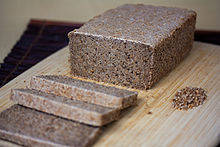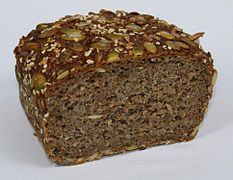隴山隴西郡
寧靜純我心 感得事物人 寫樸實清新. 閑書閑話養閑心,閑筆閑寫記閑人;人生無虞懂珍惜,以沫相濡字字真。The sprouted grain process involves soaking the grains in water until they begin to grow a sprout. The growing environment is highly controlled, including the water temp, air temp, and the time grains are allowed to sprout. Once the grains sprout, they are drained and mixed together to be ground up and used. Before the sprouted grain is used, it is a living food. Enzymes are released during the sprouting process, which break down proteins and carbohydrates. This process helps make sprouted grain food low glycemic and easier to digest. Traditional grain breads are harder to digest, and the body loses a good portion of the nutrients because it is unable to digest them. Sprouted grain breads provide the body with grain that has already been broken down due to the enzymes that exist in the living sprouted grain. Nutrients are absorbed immediately into the body, and are not lost in the digestive process.
Sprouted bread
| This article needs additional citations for verification. (February 2009) (Learn how and when to remove this template message) |
 Vegan flourless sprouted wheat bread | |
| Type | Bread |
|---|---|
| Main ingredients | Whole grains (sprouted) |
Sprouted bread is a type of bread made from whole grains that have been allowed to sprout, that is, to germinate, before being milled into flour. A particular variant, Ezekiel bread, is often said to be baked with the sins of the baker. In biblical times, this is why sprouted bread was avoided. [1] There are a few different types of sprouted grain bread. Some are made with additional added flour, some are made with added gluten, and some, such as Essene bread, are made with very few additional ingredients.
Sprouted breads[edit]
These are breads that contain the whole grain (or kernel, or berry) of various seeds after they have been sprouted. They are different from “white” bread inasmuch as “white” breads are made from ground wheat endosperm (after removal of the bran and germ). Whole grain breads include the bran, germ, and endosperm, therefore providing more fiber, and naturally occurring vitamins and proteins. Sprouted (or germinated) grain breads have roughly the same amount of vitamins per gram. Sprouted grain bread has 47% less gluten than regular bread.[2]
A comparison of nutritional analyses shows that sprouted grains contain about 75% of the energy (carbohydrates), slightly higher protein and about 40% of the fat when compared to whole grains.[3][4]
Wheat is not the only grain used in sprouted breads. Grains and legumes such as millet, barley, oat, lentil and soy may be used. Bread that is made from an array of grains and legumes can provide a complete set of amino acids, the building blocks of proteins. Sprouted breads may contain slightly more trace minerals and nutrients than non-sprouted breads. Other than that, they supply much the same advantages as whole grain breads over refined grain breads, such as lowered risk of coronary heart disease.[5]
-
Sprouted wild-yeasted whole wheat bread
Essene bread[edit]
Essene bread is a very primitive form of sprouted grain bread made from sprouted wheat and prepared at a low temperature. It is often eaten uncooked, or slightly heated, by proponents of raw foods.[6][7] The Essenes, a Jewish religious group that flourished from the 2nd century BC to the 1st century AD, are credited with the technique and basic recipes for Essene bread,[8] although no scholarly evidence exists for this claim. Sprouting and low-temperature preparation ensure the maximum possible vitamin content for this foodstuff.[8] Sprouting also breaks down the lectins and other substances that some individuals may be sensitive or allergic to.
See also[edit]
- Essenes
- Health food
- List of breads
- Malt
- Malt loaf
- Multigrain bread
- Wheatberry, a whole-wheat kernel before sprouting
- https://www.foodforlife.com/what-are-sprouted-grain-breads.htm
-
What is Sprouted Grain Bread and What Health Benefits Does It Offer
Sprouted grain bread is a healthy alternative to white flour or whole grain flour bread. Sprouted grain breads are becoming popular among health conscious people and those with mild sensitivities to wheat or gluten because of the health benefits when compared to white flour. Although, someone with moderate to severe gluten intolerance, Celiac disease, Crohn's disease, and allergies should not consume any type of product containing gluten. Even sprouted grains still naturally contain gluten. Sprouted grain bread is better not only because it uses the whole grain, but the process sprouted grains go through actually breaks down the proteins and carbohydrates in the grain, increasing vitamin content to the consumer.
The sprouted grain process involves soaking the grains in water until they begin to grow a sprout. The growing environment is highly controlled, including the water temp, air temp, and the time grains are allowed to sprout. Once the grains sprout, they are drained and mixed together to be ground up and used. Before the sprouted grain is used, it is a living food. Enzymes are released during the sprouting process, which break down proteins and carbohydrates. This process helps make sprouted grain food low glycemic and easier to digest. Traditional grain breads are harder to digest, and the body loses a good portion of the nutrients because it is unable to digest them. Sprouted grain breads provide the body with grain that has already been broken down due to the enzymes that exist in the living sprouted grain. Nutrients are absorbed immediately into the body, and are not lost in the digestive process.
The Significance of Ezekiel Sprouted Grain Breads to Healthy Living
The sprouted grain bread concept is not new. Food for Life began sprouting grains over 60 years ago to use in breads. Eating grains is mentioned in the Bible in Ezekiel 4:9, and seeds and herbs in Genesis 1:29. Food for Life has taken these recipes from the Bible and brought it to modern day health food by sprouting them to make them even more healthful. These recipes provide the body with essential amino acids needed for healthy living.
Sprouted grain breads truly unlock the vital benefits our bodies need from grains. Some of the known benefits include: increased digestibility, increased absorption of minerals, increased antioxidants, and increased vitamin C and vitamin B.
Sprouted Grain Bread from Food for Life
All Food for Life products are kosher. There is absolutely no flour used in any of our products. We only use freshly sprouted certified organic live grains. We never use any genetically modified organisms (GMO's). We do not use any refined sugars or anything artificial. That means no preservatives or shortenings of any kind are used in our sprouted grain breads or any of our products. We use a slow-bake process to preserve the natural bran and fiber benefits of grains.
Food for Life has many sprouted grain breads and other healthy products available. Some of the most popular Sprouted Grain Breads and related products include:
- Ezekiel 4:9 Cinnamon Raisin Whole Grain Bread
- Ezekiel 4:9 Flax Sprouted Whole Grain Bread
- Ezekiel 4:9 Low Sodium Whole Grain Bread
- Ezekiel 4:9 Sprouted Whole Grain Bread
- Ezekiel 4:9 Sesame Sprouted Whole Grain Bread
- Ezekiel 4:9 Almond Sprouted Whole Grain Cereal
- Ezekiel 4:9 Cinnamon Raisin Whole Grain Cereal
- Ezekiel 4:9 Cinnamon Raisin Whole Grain English Muffins
- Ezekiel 4:9 Flax Sprouted Whole Grain Cereal
- Ezekiel 4:9 Sesame Sprouted Grain Burger Buns
- Ezekiel 4:9 Sprouted Whole Grain Cereal
- Ezekiel 4:9 Sprouted Whole Grain English Muffins
- Ezekiel 4:9 Sprouted Whole Grain Hot Dog Buns
- Ezekiel 4:9 Sprouted Whole Grain Fettuccine
- Ezekiel 4:9 Sprouted Whole Grain Penne Pasta
- Ezekiel 4:9 Sprouted Whole Grain Spaghetti
- Ezekiel 4:9 Sprouted Whole Grain Tortillas
- Ezekiel 4:9 Taco Size Whole Grain Tortillas
Other products available from Food for Life include pocket breads and waffles.









